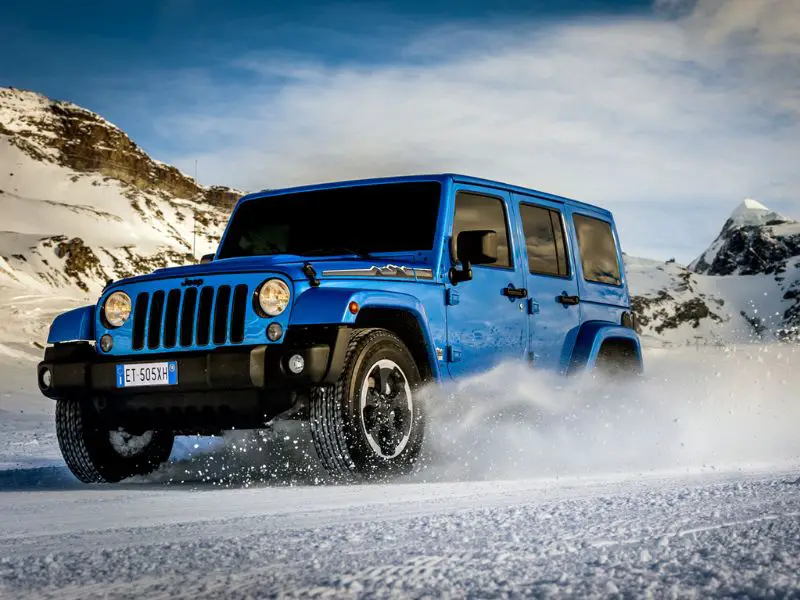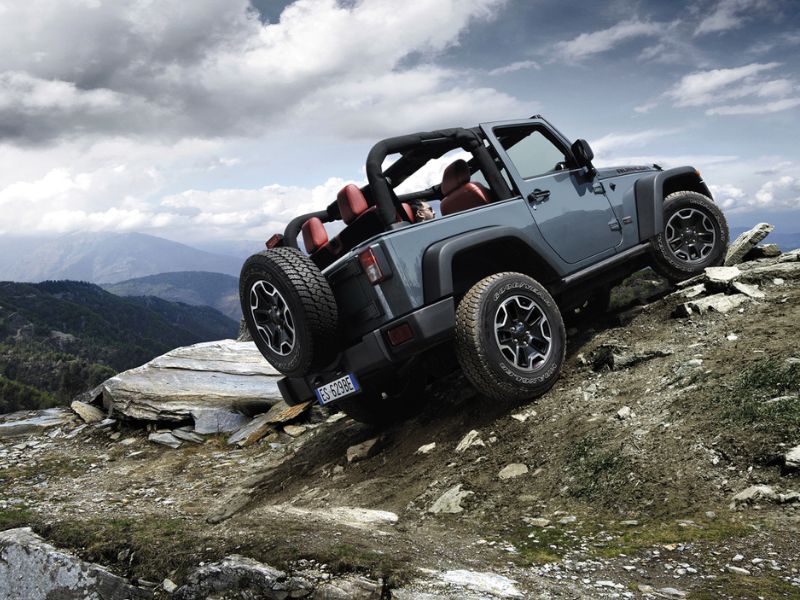The worst years for Jeep Wranglers were 2007 to 2014, these years spanned over most of the Jeep Wrangler JK lifespan, and most issues stayed the same through the years.
While the Jeep Wrangler is a staple in the offroad scene, some year models have many problems that should be avoided at all costs.
This article will look at the worst Jeep Wrangler years, along with their most common faults.

Worst Jeep Wrangler JK Problems
2007 Jeep Wrangler Problems
1. Death Wobble
The singular most reported problem registered at the NHTSA (National Highway Traffic Safety Administration) with 115 complaints.
The average cost to fix is $800, which usually occurs 72,000 miles (115,873 kilometers).
Death wobble is when the vehicle drives through a pothole or over a bump, and the steering starts oscillating back and forth uncontrollably and can cause the vehicle’s driver to lose control.
The fix primarily replaces the stabilizer shock on the steering, but numerous other vehicles have also needed the replacement of the track arms, ball joints, and tie rods.
Here is an excellent demonstration of what death wobble is:
2. Excessive Oil Consumption
The average cost to fix this is $4400, usually at 63,000 miles (101,389 kilometers).
This problem primarily focuses on the V6 models and can lead to more disastrous problems like engine failure.
Most owners complain that it is already too late when the oil light comes on because the engine has almost no oil.
You should constantly control the engine’s oil level, with some dealers saying after every fuel tank filling, which is a lot and shows a more significant fault hidden within the engine.
3. TIPM Failure
The average cost to fix is $1000, and you should start getting nervous around the 98,000 miles (157,716 kilometers) mark.
TIPM means Total Integrated Power Module, and it controls almost all electronics on the Jeep Wrangler, from wipers, headlights, side window regulators, and even some of the engine electronics that can cause you to be left stranded.
The fix is to replace the TIPM module, and while many owners found this to be the solution, others experienced the same problems a few years later.
2008 Jeep Wrangler Problems
This is the model year with the most complaints registered at the NHTSA (National Highway Traffic Safety Administration), with 1207 complaints.
1. TIPM Failure
The average cost to fix this TIPM is $960, and it generally fails around 94,400 miles (151,922 kilometers).
The TIPM failure was not resolved in the 2008 model year of the Jeep Wrangler, and it is still expensive to replace, coming in at $960, and then the chances are still there that it will fail again in a few months or years.
2. Death Wobble
The average cost to fix is $890 and happens around the 64,800 miles (104,285 kilometers) marker.
Another year and another Wrangler with death wobble, at least this model was provided with upgraded, heavy-duty stabilizer shocks.
These helped a lot, but some owners needed to replace their track bars, ball joints, and stabilizer bars.
3. Excessive Oil Consumption
The average cost to fix is $5050 and happens mostly 47,000 miles (75,639 kilometers).
While the problem persisted from the previous model year and is still only a problem the V6 models have, the engines use more oil much sooner.
The worst part is that most of the time, the damages resulting in oil consumption are on the vehicle’s owner and not the dealership or manufacturer.
So always keep an eye on that oil level if you have a Wrangler.
2009 Jeep Wrangler Problems
1. Death Wobble
On the 2009 Wrangler, the death wobble tends to occur around 73,000 miles (117,482 kilometers) and will set you back $800 to get it fixed.
In 2009 Jeep fixed multiple models by fixing the track bar mount hole on the chassis and again fitting upgraded stabilizer shocks, but the problem persists.
2. Fuel Overflowing When Filling Up
The fault here lies with the filler tube to the fuel tank; there seems to be a factory fault that causes the fuel pump not to stop when the tank is full, resulting in the person filling up the Wrangler being covered in fuel and the surrounding area as well.
The fix is a revised version of the tube and, on some models, a whole new fuel tank.
On average, the cost to repair is $660, and the problem happens around 58,700 miles (94,468 kilometers).
3. Exhaust Manifolds Cracking
The exhaust manifold cracking is a problem that V6 models only experienced; most of the time, the driver’s side or left-hand side exhaust manifold will fail.
When this happens, the exhaust gas mixture will be read falsely because some of the exhaust gas is escaping through the crack resulting in the check engine light coming on.
In some cases, this also causes the Wrangler to go into limp mode.
The average cost to fix this is $1320, which happens most commonly at 79,950 miles (128,667 kilometers).
2010 Jeep Wrangler Problems
1. TIPM Failure
Yes, the TIPM is still a problem on this model and the average cost to fix is $1340 because you will need to replace the whole module.
The failure tends to happen around the 73,250 miles (117,884 kilometers) mark.
2. Fuel Overflowing When Filling Up
Like the previous year, some models only require the fuel filler tube to be replaced, while others need the whole fuel tank to be replaced.
The average cost here to get it repaired is $990, and it usually happens around the 61,900 miles (99,618 kilometers) marker.
3. Death Wobble
The solution to the death wobble on 2010 Wranglers is generally a stabilizer shock upgrade that can help with the problem.
On average, this costs around $820, and the death wobble tends to happen around 52,900 miles (85,134 kilometers).
2011 Jeep Wrangler Problems
1. Excessive Oil Consumption
The excessive use of oil is limited to the V6 models and can cause engine failure if the oil level isn’t controlled often.
Repairs cost a whopping $5300 on average and tend to occur around 63,000 miles (101,389 kilometers).
2. Death Wobble
The death wobble was still a common problem in 2011, but the costs to have it repaired are at least the lowest, averaging around $400 for a fix.
The average mileage when it happens is 42,000 miles (67,592 kilometers).
3. TIPM Failure
The only fix here is again to replace the entire module, which costs around $960.
This failure tends to happen around 81,450 miles (131,081 kilometers).
2012 Jeep Wrangler Problems
2012 was voted the worst year for the Jeep Wrangler JK, even though it doesn’t have the most complaints.
The overall cost to repair is the highest, and the number of problems that occur is at lower mileage.
1. Faulty cylinder head
The faulty cylinder head is limited to the V6 models and can cause the engine to consume coolant.
It can also cause random misfires; even after replacing the heads, the engine is still a ticking time bomb.
Many owners reported that in only a few years of ownership, they had to replace the heads numerous times and later ended up replacing the whole engine.
The average cost to repair this is $5150 and tends to occur around 43,300 miles (69,685 kilometers).
2. TIPM Failure
The only fix here is again to replace the entire module, which costs almost $400 more than the previous year’s model at $1330.
The failure also tends to happen much sooner at around 42,000 miles (67,592 kilometers).
3. Heater Not Working
This is the pinnacle of manufacturing defects. Inside the cooling system of the vehicle is casting sand, which can cause the cooling system to malfunction and later cause engine damage.
Jeep/Chrysler are not admitting their mistake, so the owner has to pay for the heater core and radiator to be replaced and the engine to be flushed out.
There is a Class action lawsuit against Jeep over this, and so far, it does not seem like there is any new information about it.
The average cost to fix is $1040, and the average mileage when it happens is 32,750 miles (52,706 kilometers).
2013 Jeep Wrangler Problems
1. TIPM Failure
The average cost to fix is $1300.
The average mileage when it happens is 49,950 miles (80,387 kilometers).
The only fix is to replace the module
2. Death Wobble
The average cost to fix is $240, but it tends to occur at 29,700 miles (47,798 kilometers).
The fix here is to replace the steering stabilizer shock absorber.
3. Heater Not Working
The average cost to repair is $2900 and happens at around 58,700 miles (94,468 kilometers).
This is (again) caused by the casting sand trapped inside the heater core and requires a new heater core, new radiator, and engine flush.
2014 Jeep Wrangler Problems
1. Oil Filter Housing Leak
Another V6 model fault is the oil filter housing leaking. The oil filter housing is situated in the V of the engine, so seeing the leak is very unlikely until it is too late and your engine is starving of oil.
This can lead to engine damage or even failure. The only fix is to replace the oil filter housing with a new one and hope it doesn’t leak again.
The average cost to repair is $730, and it tends to happen around 51,850 miles (83,444 kilometers).
2. Brakes Not Working Correctly
In the 2014 models, a factory defect in brake calipers resulted in inadequate braking performance or wheel lockup in the rear.
There is also a chance that the brake booster is also faulty, resulting in the pedal pulsating up and down under braking but not stopping.
The average repair cost is $2170 and happens around 30,350 miles (48,844 kilometers).
3. TIPM Failure
Of the eight years of models listed here, only the 2009 model did not have major TIPM faults, making it wonder if Jeep is even trying to resolve the issue.
Getting it fixed on a 2014 Wrangler will cost around $1650 and tends to occur approximately 34,150 miles (54,959 kilometers).

Final Thoughts On The Worst Jeep Wrangler Years
As you can see, 2007 to 2014 were not great for the Wrangler. Most problems stayed with them for almost a decade; these were only the major issues from the abovementioned information. So if we had to touch on all the minor problems that crept up in 2007-2014 Wranglers, we’d need to rent a new server to host the site.
If you’re in the market for a Wrangler, try to avoid these years, but if you must get one made in this period, be aware of the repair costs and when these faults tend to occur. Also, be very thorough upon inspection.
We hope this article has shed some light on what year Wranglers you should avoid.
FAQs
What Year Jeep Wrangler Should I Avoid?
2007 to 2014 model-year Jeep Wranglers were the worst and should be avoided at all costs.
One of the worst culprits is death wobble and excessive engine oil consumption, while many more are explained in the article.
When Did Jeeps Become Unreliable?
At the end of 2006, with the introduction of the then-new Jeep Wrangler JK (third generation), reliability was going downhill.
After 2015 Jeep resolved most of the issues with the Wrangler JK.
What Is The Best Wrangler To Buy?
The first-generation YJ is the one to go for, it is robust, and the value of the vehicle is starting to rise since there isn’t a lot left that is still in good condition.
So it is an investment and a very mechanically sound vehicle.

